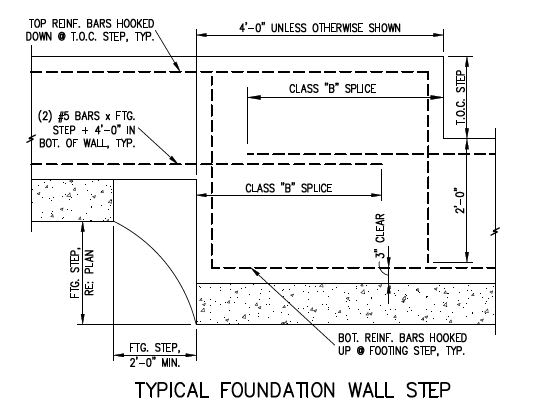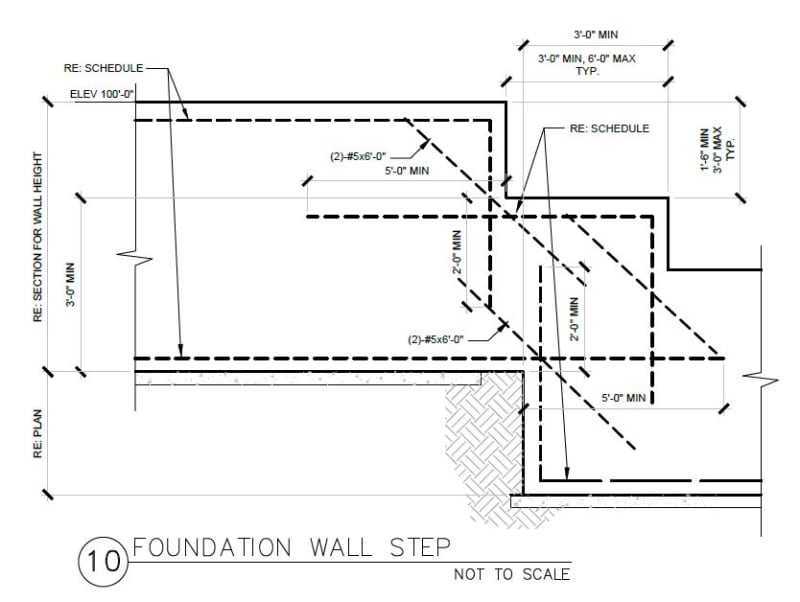I am reviewing new construction for the Owner. The footings for the basement bear at a different, lower, elevation than the garage (as that is slab on grade). They poured all the footings at once, and they did this with a roughly 12" horizontal gap, and 4 foot vertical gap between the basement footing and the garage footing. A photo is attached. There is no stepped footing, nor any type of transition. The builder insists he is permitted to do this - that the code allows up to a 4 foot offset, and the garage foundation wall carries the loads over this span footing to footing. I can no reference to such an allowance or except in the IRC. R401.1 General says "all exterior walls shall be support on continous solid or fully grouted masonry or concrete footings, crushed stone footings, wood foundations, or other "approved structural systems" that shall be of sufficient design to accomodate all loads ....". Is this spanning a legitimate thing to do?
Navigation
Install the app
How to install the app on iOS
Follow along with the video below to see how to install our site as a web app on your home screen.
Note: This feature may not be available in some browsers.
More options
Style variation
-
Congratulations MintJulep on being selected by the Eng-Tips community for having the most helpful posts in the forums last week. Way to Go!
You are using an out of date browser. It may not display this or other websites correctly.
You should upgrade or use an alternative browser.
You should upgrade or use an alternative browser.
Basement wall "spans" from footing to footing
- Thread starter Jc67roch
- Start date
- Status
- Not open for further replies.
Are you the EOR on the project? If not is there an EOR? Do the plans show stepped footings? I would start there.
1809.3 of the IBC talks about stepped footing requirements, however it appear to just say when it's needed, which in the case of your pictures, it is. Concerns include overloading the lower footing due to the loading of the higher footing creating a surcharge point load on the lower footing, frost depth, water permeability and differential settlement due to varying soil bearing capacities at different depths.
1809.3 of the IBC talks about stepped footing requirements, however it appear to just say when it's needed, which in the case of your pictures, it is. Concerns include overloading the lower footing due to the loading of the higher footing creating a surcharge point load on the lower footing, frost depth, water permeability and differential settlement due to varying soil bearing capacities at different depths.
EZBuilding
Structural
Is there a retaining wall we are missing that hasn't been formed yet?
Jc67roch:
Have the builder dig a columnar trench from the left edge of the lower ftg. form, to the right edge of the upper ftg. form, extending back under the upper ftg. 16”. Bell it out a bit at the bottom if you wish. The way that soil is standing, and if they are careful in filling this ftg. step/column, almost a if they were tremieing (sp? tremie) a deep pier, form the outer three faces 16” out onto the lower ftg. You don’t want them just throwing conc. in that hole and knocking clods of dirt into the mix as they fill it. Put in a few verts. and some bent rebars from each of the main ftgs. Does that jog in the garage ftg. plan happen at the o.h. door jamb or in the middle of the door? Neither place is a good location for differential settlement. Don’t let them just stab the A.B’s. into the tops of the walls. What about found. waterproofing and outside drain tile? Don’t let them backfill that found. with the crap diggings they have piled up around the bldg.
Have the builder dig a columnar trench from the left edge of the lower ftg. form, to the right edge of the upper ftg. form, extending back under the upper ftg. 16”. Bell it out a bit at the bottom if you wish. The way that soil is standing, and if they are careful in filling this ftg. step/column, almost a if they were tremieing (sp? tremie) a deep pier, form the outer three faces 16” out onto the lower ftg. You don’t want them just throwing conc. in that hole and knocking clods of dirt into the mix as they fill it. Put in a few verts. and some bent rebars from each of the main ftgs. Does that jog in the garage ftg. plan happen at the o.h. door jamb or in the middle of the door? Neither place is a good location for differential settlement. Don’t let them just stab the A.B’s. into the tops of the walls. What about found. waterproofing and outside drain tile? Don’t let them backfill that found. with the crap diggings they have piled up around the bldg.
While my reinforcing detail was somewhat different than that of dauwerda . I am sure I have more than a thousand designs which did not 'tie' the upper a lower footings together before the wall placement. I always thought it a waste of time & effort connecting the upper & lower footings prior to wall placement.
- Thread starter
- #11
Thank you all for weighing in on this. I am an independent engineer "inspecting/reviewing" construction for the Owner as it is being built. The builder is difficult to get plans from, so I am in that process. Sounds like it is standard practice in the residential industry, the details Dauwerda shared are what this builder apparently does. The wall, when cast, spans the gap. But I agree with others that I don't like it. Seems it would ripe for cracks, overloading, and settlement issues at that gap area.
If you don't have the plans showing the design by others, I would be cautious to provide any review/inspection as it would seem to me you just became liable for the design and anything they do as you have no point of basis (plans) to show a different way of building this.
- Status
- Not open for further replies.
Similar threads
- Question
- Replies
- 2
- Views
- 8K
- Replies
- 10
- Views
- 6K
- Locked
- Question
- Replies
- 6
- Views
- 3K
- Replies
- 8
- Views
- 12K
- Locked
- Question
- Replies
- 4
- Views
- 585


